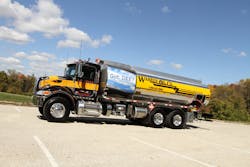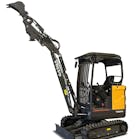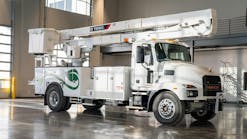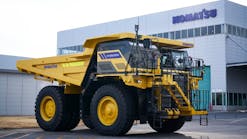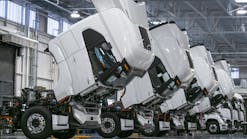Since 2010, diesel-powered on-highway trucks in North America have been using selective catalytic reduction (SCR) as an exhaust after-treatment technique to control nitrogen-oxide (NOx) emissions. And for the most part, the chemical that makes SCR work, diesel exhaust fluid (DEF), has been handily available at parts stores, truck stops, gas-station chains, and stationary bulk systems in truck-fleet terminals. But for many users of off-road equipment, SCR is new technology, and the logistics of getting DEF to job-bound machines working on remote sites is not as simple as pulling up to the pump at a truck stop.
More SCR, DEF Resources
Aaron Mayer, equipment manager for Ryan Incorporated Central, Janesville, Wis., voices his concern: “None of the fuel vendors we use today have an efficient system for dispensing DEF, especially in remote locations. It seems the problem is that these companies don’t have enough Tier 4 machines in their territory to justify adding a DEF tank to their truck.
“Using jugs [1- and 2.5-gallon containers] would work if you had just a machine here or there, but for a fleet of haulers, that could be a lot of jugs—and cleanliness becomes an issue. And with a tote [275- or 330-gallon container], how do you keep it out of direct sunlight, because most totes are translucent, or keep the DEF temperature out of the extremes, or find a corrosion-resistant pump to dispense it—and how will the pump be powered?”
Mayer says that the company has considered adding a tote to a lube truck, but concluded that insufficient floor space works against the idea. Ryan does own fuel trucks, which are used in areas where vendors are not available to “wet-hose” equipment—directly fill the vehicle tank—but has not yet experimented with adding DEF tanks to these vehicles, which would require retrofitting with DEF-compatible equipment.
According to Mayer, the company likely will have more than 50 large Tier 4-Final machines by next year, requiring sizable volumes of DEF, and needs to have a workable solution by then.
“Long term, I think DEF will be dispensed with fuel,” says Mayer, “but there’s an interim problem with just a few people making deliveries to just a few Tier 4 machines. But as population increases, justification for fueling vendors to invest in specialized DEF equipment will be easier. In the meantime, we’ll probably work on developing our own tote system with filters and an air or electric pump.”
DEF-supply examples
Some fuel suppliers, however, are addressing the logistics of delivering DEF to remote sites. For example, Al Warren Oil Co., based in Summit, Ill., with terminal facilities in Chicago and Indianapolis, Ind., has a fleet of dedicated tankers that transport DEF from major distributors to its terminals. From there, specially built delivery trucks, with tanks to accommodate reasonably large volumes of both diesel and DEF, supply customer sites.
According to Tyler Shepherd, Al Warren Oil’s supply and trading manager, the company’s normal practice is to deliver both fluids to customers who have on-site bulk-storage systems, but can be flexible if the situation requires.
“We do have customers that want us to wet-hose each piece of equipment, but that’s really not cost-effective for us—nor for the customer,” says Shepherd. “But if the customer is working away from home base and willing to pay for wet-hosing, we accommodate them.”
Alan Smith, DEF business development manager for Brenntag North America, among the largest DEF distributors, is of like opinion: “Wet-hosing is a tough issue—even with the on-highway sector. Some [fuel vendors] out there are doing it, but it’s creating a lot of challenges. For instance, if mileage isn’t being monitored, you might pull out the hose and only a gallon is required. So that’s most likely an order that amounts to less than $3.00 for that truck.”
Smith says that some fuel vendors capable of wet-hosing equipment are setting minimum order quantities, saying, “If you want this service, then no matter how few gallons we dispense, we’re going to bill you X amount.”
On the off-road side of the business, Brenntag has an agreement with Volvo CE, Volvo Penta, and Komatsu to supply DEF to their dealer networks: “Volvo might come to us, for example,” says Smith, “and say, ‘we have an opportunity at this construction site,’ so Brenntag might install a turn-key dispensing system using totes, then evaluate the best method of DEF delivery, which could be one of our trucks or a third party.”
Judging from the comments of a number of equipment distributors in large metropolitan areas and representing a cross-section of machine brands, many of them are choosing to stock only jugs of DEF, finding that the drums and totes available through their manufacturers’ parts systems are, for the most part, priced significantly higher than the same items available through local fuel vendors. But that said, all seemed willing to accommodate their customers’ needs.
Closed DEF systems
Keeping DEF contaminant-free is absolutely essential to protect the sensitive catalyst in the SCR system, and to that end, most DEF drums, totes, and bulk-storage containers use a sealed closure that prevents the container from being opened during dispensing—preventing, for instance, opening the container to insert a pump pickup.
“The containers that producers and distributors use to package DEF are ‘closed’ with an integrated container-valve assembly that is never to be removed during the container’s service life,” says Jeff Smigiel, business development/marketing manager for Micro Matic Closed Chemical Systems. “The closure assembly is designed to protect DEF from unauthorized users, adulteration, and environmental contaminants.”
The container-valve assembly, says Smigiel, uses a spring-loaded, self-closing seal that keeps the container closed and protects the container’s integrity through the supply chain. A tamper-evident device is used to secure the valve to the container, he says, and if the device is broken, the container likely has been opened and DEF purity possibly compromised.
DEF can be dispensed from a closed-system container, says Smigiel, only by inserting and locking a compatible, four-keyed dispensing coupler into the container’s closure, then connecting DEF-compatible hoses, pump, and nozzles. In addition, the dispensing valve further protects DEF purity, he says, by using an integral one-way check valve that permits flow only from the container, thus preventing inadvertent refilling of the container with non-DEF fluids.
“The dispensing coupler also is typically fitted with a small ‘umbrella valve’ that actuates when the pump is on and dispensing,” says Smigiel, “allowing the DEF container to breathe when fluid is extracted. If the dispensing environment contains high levels of dust and airborne debris, couplers are available with a filter in the breathing port.”
Brenntag’s Smith cautions DEF users to make sure DEF containers are installed with sealed closures that are obviously intact: “A lot of players are chasing the [DEF-supply] gold rush out there, prices are going down, and some are taking shortcuts [by not using compatible, closed-system filling/dispensing equipment]. Closed-system equipment is expensive, so there are people who say, ‘I’ll just crack the cap and fill the tote.’ Now you have the container open, allowing entry of dust particles from the job site.”
Smith also encourages DEF users to ask their suppliers about delivery methods. Some suppliers use third-party contractors to actually make deliveries, he says, and “some are better than others.” He suggests asking the supplier about the source of the DEF and what type of closed system is used during refilling.
“What’s most important with DEF,” says Micro Matic’s Smigiel, “is purity. The ultimate objective is to deliver DEF all the way from the producer, through the supply chain, to the vehicle’s tank and maintain specification.”
The most vulnerable point for compromising DEF purity is, in fact, when the vehicle tank is filled. Some vehicle manufacturers apparently are experimenting with a closed-system-type cap for the vehicle’s DEF tank, and although such a closure would eliminate a possible avenue of contamination, some are concerned that a closed cap might complicate the filling process when using jugs.
A related issue is that of inadvertently placing DEF in the vehicle’s diesel tank, says Steve Cox, national sales manager for Separation By Design, a company supplying DEF storage and dispensing systems under the KleerBlue brand. The diesel nozzle, at 22 millimeters, doesn’t fit into the opening of the DEF tank, but the 19-millimeter DEF nozzle can easily be used in the diesel tank. According to Cox, the DEF nozzle can be equipped with a magnetic device that prevents operation unless it passes through a mating magnetic collar in the neck of the DEF tank. The diesel tank, lacking the magnetic collar, prevents the DEF nozzle from opening.
Off-road-supply possibilities for DEF
According to Separation By Design’s Cox, the company’s extensive KleerBlue product line includes such equipment as turn-key bulk installations, DEF transfer systems, insulated/heated enclosures for totes, drum dispensing systems, skid-mounted portable dispensing systems, and a two-wheel cart (110-volt) that pumps DEF from a tote on a flatbed or box truck into vehicle tanks. The portable skid-mounted systems are powered via a gasoline engine or by a portable-generator/electric pump combination.
The company also has developed an insulated/heated dispensing system, with a 60- or 100-gallon tank, that is side-rail mounted to fuel trucks for wet-hosing equipment. The system, says Cox, complies with the Weights and Measures provisions of the National Institute of Standards & Technology. Also new in the company’s product range, developed with an eye toward off-road wet-hosing, are 50- and 100-gallon dispensing systems designed to fit in the bed of a pickup truck.
Thunder Creek Equipment’s product range also includes a pickup-truck-mounted DEF-dispensing system, a 50-gallon tote-style. The company’s DEF-handling equipment extends to larger alternatives as well, including lube/service trailers that can accommodate a DEF tank into their multi-tank/multi-fluid design, fueling trailers that can accommodate DEF volumes from 40 to 330 gallons and fuel volumes from 500 to 990 gallons, plus DEF-specific trailers that can handle 500 or 990 gallons. The latter, says the company’s Jean Van Wyk, are potentially for use in wet-hose fueling operations.
All Thunder Creek systems feature the company’s patent-pending “Two-in-One” pumping system, which allows one set of hardware both to dispense DEF into a vehicle’s tank from a bulk container in a pickup truck or trailer—as well as to refill the bulk container. Micro Matic closed-system components are used to protect DEF purity during both operations. In addition, the company’s DEF tanks are designed to allow room for expansion if DEF freezes, says Van Wyk, thus protecting tank integrity. About 25 percent of customers, she says, choose tank-heating options.
DEF purity
Frank Cook, Ph.D., chief technical officer for Old World Industries, a major producer of DEF, which is marketed as BlueDEF by Peak Commercial & Industrial, reminds equipment owners that handling DEF requires dedicated equipment: “Even something as simple as a funnel to pour DEF from a one-gallon container into the vehicle tank needs to be used only for that purpose—don’t use it to change oil or add antifreeze.” (Download an infosheet on DEF handling below.)
Cook illustrates DEF’s susceptibility to contamination by saying that a single teaspoon of table salt mixed into a 5,000-gallon tanker load is enough to contaminate the entire volume. The need to keep DEF free of contaminants, says Cook, as well as the requirement to use compatible materials in its handling (DEF is corrosive to certain metals) have prompted an entire equipment industry to grow up around DEF. Stainless steel and high-density polyethylene (a thermoplastic made from petroleum) are the most common materials used for DEF-handling equipment.
According to Cook, ISO (International Standards Organization) 22241 is the comprehensive standard that has been developed to set exacting specifications for DEF and to protect its purity through manufacturing, storage, handling, and transport. Every link in the supply chain is obligated to adhere to the standard. Product that complies with ISO 22241, says Cook, carries that designation on its packaging, as well as the American Petroleum Institute (API) “Certified Diesel Exhaust Fluid” badge.
“We analyze every batch,” says Cook, “and I think every other reputable DEF manufacturer does the same. The industry has had little problem with off-spec DEF being sold in the marketplace. Large distributors are buying DEF in 5,000-gallon truckloads, placing it in their tanks, and then filling totes and drums—and this could be a potential source of contamination. But in the four years that we’ve been doing this, the only issue of consequence is dust—particulate matter.”
Cook cautions DEF users with bulk installations to make sure that breather ports on large tanks are fitted with appropriate filters.
“One of the ISO specs is for insoluble material,” says Cook, “because the exhaust is passing through a catalytic converter, and insoluble material can potentially plug the honeycomb structure of the catalyst. In the field, managing DEF quality means controlling dust and particulates, as well as being careful not to cross-contaminate DEF handling equipment with other fluids.”
